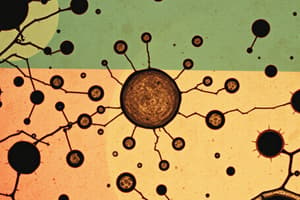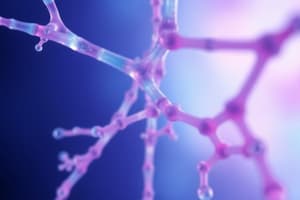Podcast
Questions and Answers
মানুষের দেহটি কতগুলি প্রধান ব্যবস্থানে ভাগ করা যায়?
মানুষের দেহটি কতগুলি প্রধান ব্যবস্থানে ভাগ করা যায়?
- ১
- ৮
- ৭ (correct)
- ৫
হৃদয়ের কাজের মধ্যে কি?
হৃদয়ের কাজের মধ্যে কি?
- নাসা
- রক্ত (correct)
- অন্তরিভা
- মাংসপেশী
নিম্নোক্ত কোনটি 'নিঃশেষ'?
নিম্নোক্ত কোনটি 'নিঃশেষ'?
- পায়ু
- নাক
- অন্তরিভা
- নিচে (correct)
'নিঃশেষ'ের অর্থ হৃদরোগ?'
'নিঃশেষ'ের অর্থ হৃদরোগ?'
'Respiratory System' -এর মৌলিক 'organ' -টি কি?
'Respiratory System' -এর মৌলিক 'organ' -টি কি?
জীবিত জীবনের সমগ্র অংশ অধ্যয়নের জন্য প্রাথমিক স্তরে কোনটি বিভিন্ন কোষের মধ্যে সংযোজিত?
জীবিত জীবনের সমগ্র অংশ অধ্যয়নের জন্য প্রাথমিক স্তরে কোনটি বিভিন্ন কোষের মধ্যে সংযোজিত?
কোন অর্গানিজেশনের একাধিক সিস্টেমের মিলনের ফলে জীবন বন্ধন কেন্দ্রীকরণ করে?
কোন অর্গানিজেশনের একাধিক সিস্টেমের মিলনের ফলে জীবন বন্ধন কেন্দ্রীকরণ করে?
নিউরোনের জন্য 'নির্দেশনা' এবং 'নিযাম' দু'টি অন্তর্নির্দেশনা '...
নিউরোনের জন্য 'নির্দেশনা' এবং 'নিযাম' দু'টি অন্তর্নির্দেশনা '...
'TEM' মাইক্রোস্কোপ প্রায় '...' এর পূর্বানুরূপ।
'TEM' মাইক্রোস্কোপ প্রায় '...' এর পূর্বানুরূপ।
'Virus' '...' to '...' থেকে '...'।
'Virus' '...' to '...' থেকে '...'।
Study Notes
Life Science: A Journey through Cells, Systems, Functions, Organs, Microscopes, and Viruses
Life science is a broad discipline that encompasses the study of living organisms—their structures, functions, growth, evolution, distribution, and interactions with their environment. Here we'll delve into some key aspects of life science, including cell structure and function, the various systems within cells and organisms, how these systems work together to maintain life, the role of organs in our bodies, different types of microscopes used in this field, and the journey from microcronic to nano-scale viruses.
Cell Structure and Function
At the core of all living things are cells—microscopic units that carry out many essential functions. There are two main types of cells: prokaryotic cells found in bacteria and archaea, which lack membrane-bound nuclei; and eukaryotic cells like those in plants, animals, fungi, and protists, which have membrane-bound compartments called organelles.
Cells contain three major components: the plasma membrane, which separates them from other cells and protects them from the external environment; the cytoplasm, where most cellular activities occur; and the nucleus, containing genetic material such as DNA. These structures allow cells to grow, reproduce, and respond to stimuli from their surroundings.
Systems within Organisms
Within multicellular organisms, specialized groups of cells form tissues, which serve specific roles in maintaining the body's functions. Tissues are organized into organs, each with distinct structures and functions. For example, the heart pumps blood throughout the body, while the liver filters waste products from the blood stream.
The human body can be broken down into several major systems, each with its own set of organs and functions:
-
Digestive System: Consisting of the mouth, esophagus, stomach, small intestine, large intestine, rectum, and anus, it breaks down food into nutrients that can be absorbed by cells.
-
Respiratory System: This includes the nose, throat, larynx, trachea, bronchi, lungs, and diaphragm. It allows us to breathe and exchange oxygen and carbon dioxide between the air and our bloodstream.
-
Circulatory System: Comprising the heart, arteries, veins, and capillaries, it transports oxygen, nutrients, hormones, and other molecules around the body, while removing waste products and carbon dioxide.
-
Excretory System: Includes the kidneys, bladder, ureters, and urethra, which filter waste materials from the blood and excrete them as urine.
-
Endocrine System: Made up of glands, such as the pituitary, thyroid, parathyroid, adrenal, pancreatic islets, ovaries, testes, and pineal gland, it secretes hormones that regulate growth, metabolism, reproduction, and stress response.
-
Nervous System: Consisting of the brain, spinal cord, and nerves, it processes sensory information, coordinates responses, and controls voluntary movements.
-
Skeletal System: Contains bones, joints, cartilage, muscles, tendons, ligaments, and other connective tissues that provide support, protection, and movement.
-
Muscular System: Comprised of skeletal muscles, smooth muscles, and cardiac muscles, it generates force and movement, while also maintaining body temperature and blood pressure.
Microscopes and their Role in Life Science
Microscopes are essential tools in life science, allowing scientists to observe and study structures and processes at the microscopic level. There are several types of microscopes designed for different purposes:
-
Light Microscopes: These use visible light to magnify objects, typically up to about 1,000 times their original size.
-
Electron Microscopes: These employ a beam of electrons to illuminate samples, providing much higher magnification (up to 1 million times) but requiring special sample preparation techniques.
-
Fluorescence Microscopes: These use light of one wavelength to excite a fluorescent dye or a fluorescent protein within a sample, and then detect the light of a longer wavelength emitted by the dye or protein.
-
Atomic Force Microscopes (AFM): These use a sharp tip to probe the surface of a sample, measuring forces between the tip and the sample at the atomic level.
Turning a Microcronic to Nanometre Virus
To understand the journey from microcronic to nano-scale viruses, we first need to look at the size of the viruses themselves. Viruses are submicroscopic infectious agents that require a host cell to reproduce. They range in size from 20 nanometers (nm) for the smallest viruses to 300 nm for the largest.
The term "microcronic" is not a term used in the scientific community. However, we can consider the smallest viruses, such as the picornavirus, which can be as small as 20 nm. As technology has advanced, scientists have been able to study smaller and smaller structures, and viral particles can now be studied at the nanoscale.
In terms of the journey from microcronic to nanometre viruses, it's a matter of technological advancements in microscopy and imaging techniques. For example, cryo-electron microscopy (cryo-EM) has allowed scientists to visualize viral structures at the nanoscale, revealing details previously unseen. As technology continues to evolve, we can expect to see even smaller structures and processes being studied in the field of life science.
Studying That Suits You
Use AI to generate personalized quizzes and flashcards to suit your learning preferences.
Description
Delve into the fascinating world of life science with a focus on cell structure and function, the various systems within organisms, the role of microscopes in scientific research, and the journey from microcronic to nano-scale viruses. Learn about cells, tissues, organs, and major body systems, as well as the different types of microscopes used in life science research.




